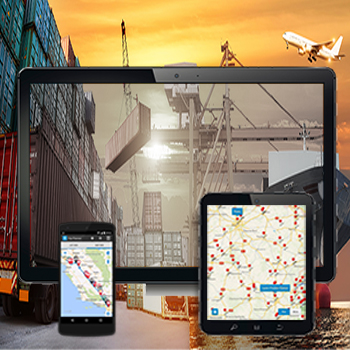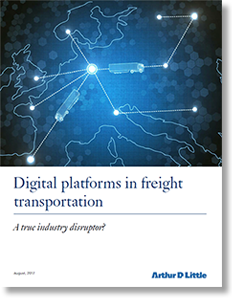Logistics & Supply Chain Technological Innovation
In these days of ever-increasing technological innovation, the advances being made in logistics and supply chain are certainly gaining the attention of the Silicon Valley elite.
And perhaps nowhere is that more apparent than in the proliferation of app-based - or on-demand - trucking providers, a quickly emerging area that’s receiving a significant amount of attention and investment.
While signs are pointing to higher truckload rates and continued capacity tightness, new options for securing loads for shippers are expanding on the brokerage side through well-funded start-ups and established logistics services stalwarts.
Many believe that they’re taking the technical steps required to not only enter the market but to succeed in this business where margins are already razor-thin.
In an effort to put this well-hyped trend into better perspective, Logistics Management welcomes John Larkin, managing director, transportation and logistics, at Stifel Equity Research; Chris Cunnane, senior analyst on the supply chain and logistics team at ARC Advisory Group; and Evan Armstrong, president of third-party logistics provider (3PL) analyst firm Armstrong & Associates.

WHow would you best define this on-demand or app-based approach to freight transportation?
Chris Cunnane: Most people refer to this model as the “Uberization of freight.”
However, it’s more of a digital freight matching service.
Simplified, it means that drivers can use a mobile app to match their available truck with a pending load.
The driver will get an alert for a pick-up and can choose to accept the load if the price and timing are right.
There are two main markets that can be served in this model - long-haul trucking and last-mile deliveries.
When you look at the long haul, this market can be segmented into two distinct areas -committed and the spot market.
However, the last-mile side has more opportunity for growth.
Evan Armstrong: Like Chris, we simply describe them as digital freight matching companies.
For the most part, they aim to match shipper demand for transportation with carrier truck capacity through digital or mobile-based platforms, usually in the form of apps.
Who are some of the key players that are moving into this space and what is the true impact of Uber on this market?
Cunnane: There are hundreds of millions of dollars pouring into the market, on both the long-haul and last-mile side.
Uber and Amazon are both developing apps to become the “leader” of the digital freight matching space since they have the capital and they have the contacts.
Other key players include Kuebix, Fourkites, Cargomatic, Convoy, and CargoX, among others.
However, this is more on the long-haul side of the market. For last-mile, more than $500 million of funding has been raised by start-ups, and this looks like the more viable option, with companies like Instacart and Deliv proving their business model.
Armstrong: In terms of “Uber-like” companies, at this point, the impact seems minimal because many are small to mid-sized freight brokers with an app and online interfaces. We would put Uber, Transfix, uShip Pro, Convoy, Load Express, and Next Trucking into this category. They tend to be very small in comparison to domestic transportation management leaders C.H. Robinson, Hub Group, XPO Logistics, Coyote Logistics, and Total Quality Logistics (TQL) - each of which has over $2 billion in revenue in the $62 billion domestic transportation management market segment.
John Larkin: Most of the big brokers already have apps for facilitating communication. My sense, however, is that Bill Driegert at Uber has a different plan than most of the others. He wants to eliminate phone calls from the process of matching a load with an empty. The match will be made with the help of data analytics-based algorithms, in seconds.
On top of that, the people at Uber will be compensated with salary and bonus rather than a commission based on volume or the spread between the buy and the sell on capacity. This will enable them to focus on service excellence and customer penetration.
We also know that Uber has a lot of resources to bring to the party, not the least of which is a management team with a lot of experience in freight brokerage, access to hundreds of data scientists, access to the underlying code that drives the Uber passenger app, and a deep-pocketed corporate parent that places a higher priority on growth than on profitability, at least initially.
Given the proliferation of entrants into this market, what will separate the long-term, successful players from the ones that don’t take off?
Armstrong: It is all about scale, the number of shipments you have flowing through your app or online platform. Without scale, shippers won’t be able to secure carrier capacity at competitive rates and carriers won’t find loads. Load-posting-centric companies such as DAT and Truckstop have significant volumes and scale, allowing 3PLs and shippers to find carriers to handle loads.
But because rate negotiation and transportation execution are done offline, it will be interesting to see how they expand their future service offerings. Trucker Path is trying to leverage its carrier apps to build carrier capacity to offer to shippers and 3PLs, while uShip does well in the consumer-to-consumer space supporting different auction sites.
Larkin: The wheat will be separated from the chaff on the basis of the following attributes: access to capital; intimate knowledge of the intricacies associated with freight transportation; the ability to reach significant scale, say $1 billion in gross revenues; the ability to keep transactional unit costs low by automating many brokerage functions currently performed with a high level of labor content; and the ability to provide outstanding service.
The new leaders will also have to exhibit the ability to continuously optimize modal split and load allocation to carriers while minimizing cost and meeting or exceeding agreed upon service standards. We also believe that winners will adopt blockchain as a foundational transaction processing approach and will find a way to hedge its exposure to rapidly rising or quickly declining spot rates.
Cunnane: Evan and John are right on. I’ll add that one of the biggest things will be perceived. By that, I mean that there’s that trust that the company can handle the business without letting service levels dip. But when you boil it down, there are too many companies entering a crowded space.
Large shippers have contracts with large carriers, and there’s a trust factor that can’t be ignored. However, opportunities exist in the spot market, the international freight market, and owner-operator/small carrier market. Digital freight matching enables backhauls for smaller carriers as well as the opportunity to fill capacity on LTL deliveries.
What types of stakeholders are making the move into this segment and why?
Cunnane: Uber and Amazon are making a push to develop fully functional digital freight matching apps. Their main advantage is deep pockets. Most of the smaller companies are looking at venture capital firms to fund the business with the promise that the market is poised to grow.
However, the market is basically an unknown entity, with a variety of challenges for companies to overcome, including existing contracts, adequate savings, security concerns, and service issues.
Larkin: As in most areas of transportation and logistics, there are two primary stakeholder groups: the strategic players and the financial players. J. B. Hunt Transport Services is an example of a strategic player that’s planning to invest $500 million in developing the capabilities that we described.
TPG, a private equity firm, on the other hand, just established a foundational platform by buying Transplace. It will make capital available that will allow Transplace to grow faster organically or via acquisition. Venture capital players also like this space, as wealthy executives from tech industries hope to identify the next big thing.
Armstrong: Digital freight matching apps have tallied approximately $300 million in venture capital and private equity funding. Investors seem to buy the pitch that these companies are truly unique and will disrupt the transportation marketplace like Uber has with its ride-hailing app.
However, while some apps may have innovative tech capabilities, most lack scale and have limited capability to disrupt established B2B relationships in the more complex $742 billion U.S. trucking market.
We anticipate that digital freight matching companies with the best technologies will be acquired by IT firms or 3PLs interested in incorporating the technology into their systems. Think Kiva, which is now Amazon Robotics, or DB Schenker’s exclusive deal to utilize uShip in Europe.
How do the established truckload brokerages continue to differentiate themselves from the start-ups and make further inroads in the market in terms of scale and market share?
Cunnane: Established truckload brokerages are just that: established. They are a known entity, with service commitments and a track record of performance. They’re not out trying to raise money and prove their business model can work.
Additionally, the start-ups that are making an entry to the market don’t have optimization engines that are required to find low-cost modes and efficient routes to maximize savings.
Larkin: Differentiation comes with the breadth of modal offerings, the extent of geographic coverage, ease of use, service quality, tracking and tracing, and the ability to reduce costs without harming service levels. Also providing differentiation is a firm’s ability to sell its whole menu of services through one sales contact.
Armstrong: Established 3PLs, such as C.H. Robinson and Coyote, spend more on IT development than any of the digital freight matching startups and have much larger network scale and transportation spend. We’re talking about multi-billion dollar organizations managing thousands of shipments per day.
Each has invested significantly in the carrier facing smartphone applications in addition to customer portals and proprietary transportation management systems (TMS).
In addition to managing full truckloads, they also have transportation planning capabilities that can optimize mode selection as well as consolidating LTL shipments into multi-stop truckloads. Plus, they often work with multiple truckload modes, LTL, and intermodal rail.
What will the app-based trucking market look like in five years?
Larkin: Our sense is that there will be between five and eight big players with great technology, a wide breadth of services, scale, terrific people, and a demonstrated ability to save shippers money. Certain existing companies will certainly make the cut: C. H. Robinson, Coyote and TQL immediately come to mind as likely winners.
Echo Global Logistics, XPO Logistics, J. B. Hunt, Schneider, Amazon, Uber, and Google are all certainly well-positioned to make it to the next level.
Of course, the European- and Asian-based logistics enterprises could be the wild cards here. Others, like the app-based start-ups, may struggle to survive or may combine with some of the aforementioned winners.
There will certainly be a lot of moving parts over the next five years for all of us to watch. And indeed, the unfolding events should prove to be entertaining to those of us who spend our lives in this rapidly changing industry.
Armstrong: While the top 30 freight brokers account for over 40% of the U.S. 3PL domestic transportation management market segment net revenues, there’s still significant fragmentation.
Those Uber-like digital freight matching companies that can gain scale - around $300 million in purchased transportation - and be competitive should prosper.
This space is ripe for new entrants and technological innovation, and we anticipate that the trend toward increased consolidation at the top with plenty of smaller competitors will continue.
Cunnane: In five years, the market will not look that different. I see a period of acquisitions that will limit the number of companies in the space, as well as a number of companies that simply can’t stay afloat.
Uber and Amazon will have their share of the market, but the market poses many complexities and challenges for it to really scale.
The biggest issue, other than a lack of optimization, is the fact that a system that allows shippers to tender to carriers and book and pay for the shipment already exists. It’s the transportation execution systems market - which is already a well established $600 million market.
It’s a combination of software providers and freight marketplaces that encompasses everything the app-based approach does, while often embedding analytics.
Related: Digital Freight Matching the New “Little Black Book”
Related Resources
Digital Platforms in Freight Transportation
This paper details how logistics service providers need to step up their game and not be afraid of digitization, and how to secure leading market positions for years to come. Download Now!
Digital Disruption in Freight & Logistics
This paper describes why digital capabilities are critical to meeting the challenge of digital disruption successfully, and how incumbents need to consider and drive this “rotation to the new” as a conscious and deliberate act of renewing and transforming their core business. Download Now!
A Shipper’s Guide to Load Boards
This white paper describes how the best load boards are those that implement security protocols and offer due diligence tools to create a secure and transparent marketplace for their customers and provides all the tools a carrier needs to qualify new partners, minimizing paperwork and streamlining the negotiation process.. Download Now!
The Complete Buyer’s Guide to Transportation Management Systems
There is almost no limit to how a Transportation Management System can benefit your unique supply chain, but the key to success is finding the right one for your goals, so, before selecting a TMS, use the 12 questions in this buyer’s guide to find the best solution for your company. Download Now!
More Resources on Freight Transportation
About the Author
Follow Robotics 24/7 on Linkedin
Article topics
Email Sign Up























